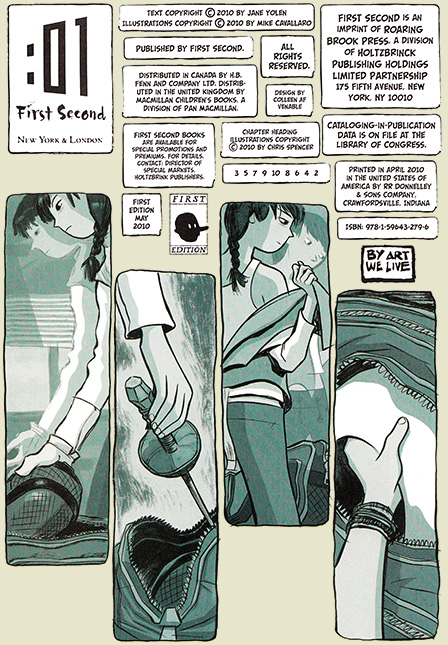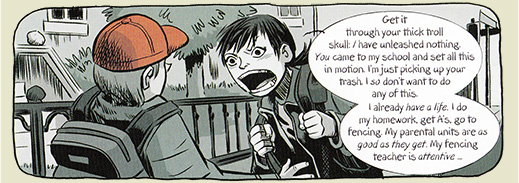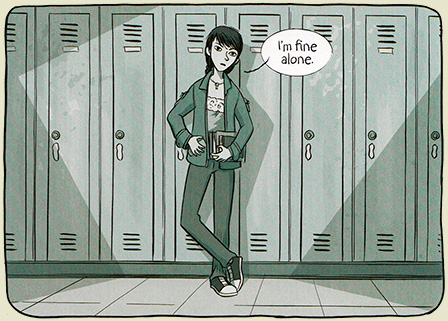Foiled: Vols 1 and 2
Created by: Jane Yolen and Mike Cavallaro
Published by: PUBLISHER
ISBN: 1596432799 Amazon
Pages: 320



I've being toying with the idea of giving up reviewing things I'm not especially enthusiastic about. Certainly there's something deeply self-satisfying about venting all the bile accumulated through trudging amongst particularly gruesome examples of creative detritus. It's fun and it gives both critic and reader a chance to laugh (if the reader agrees with the critic). But I'm growing less and less comfortable with the exercise as part of Good Ok Bad. After all, despite the site's title (which I maybe sorta regret a little now), my primary goal and interest is to evangelize people to the value and good to be found in the comics medium.
If I were to have a mission statement, it would lean heavily on the concept of helping people find comics, graphic novels, and manga that they will enjoy and find value in. Reviews of Bad books don't have anything to do with that mission. This is the large part, probably,11The other part is that I have a tendency to leave books I'm not enjoying completely unread. And since I won't review an unread book, that means I have a pretty small pool of Bad books to choose from. why such a slim percent of my reviews are One-Star Books.
Foiled and its sequel are not Bad books, but the problem is similar. They aren't books I would probably promote to many people. They are Okay—books with some good to recommend them but a number of issues that diluted my enjoyment of their contents. That's fine because not every book is going to be stellar and not every book is going to be one that appeals to my sense of what Good is. All the same, being lukewarm toward a book makes it hard to speak about with any kind of passion. I'm not recommending something, so my purpose is diminished. I'm not warning the reader away from something dreadful either. There's not even really anything to poke fun at. It's just a book series with a decent idea that doesn't measure up to my sense of what makes good storytelling.
And it started out so well too.

Foiled's first volume opens with some beautiful art direction. Mike Cavallaro's art can be exquisite at times. The title page features the book's principal, Aliera, in fencing gear. It could be a throwaway panel, but instead Cavallaro uses it to push a wonderful silent narrative of the girl. The perspective is low-angled and the reader encounters the protagonist for the first time as someone strong, well-guarded, and probably pretty talented.

The following pages, including the artfully prepared indicia, take the reader through Aliera's self-disarming ritual and we see the girl move from her place of power into an identity of comparative weakness. It's a good visual allegory for how Aliera's life works itself out and is accomplished silently, through art alone. While I know it would have been impossible to eloquently develop the story of Foiled had the book continued wordlessly, less words may have saved the book from the bulk of its missteps.
I had not heard of Jane Yolen or her work prior to reading Foiled. I read a couple of her titles off the rear cover to my wife (apparently Yolen has like 300 books under her belt) and she said, "Whoa. Owl Moon' famous. She's famous. It won a Caldecott." Those may not have been her exact words, but they rode along those lines. With that in mind, I'm not sure what happened. Maybe Yolen is just uncomfortable with the comics medium. Maybe she thought comics are the future and she should get on that ride but really doesn't respect the medium for what it can do. Maybe she's still super talented but is just writing in a slump. I can't possibly know the Why behind the reason these two books are so poorly written, but they are.
I'm aware that YA books are often written with teenage figures who speak not as teenagers but instead as teenagers imagine themselves to talk. So when Aliera narrates in a voice that feels wholly untrue to her demographic (the teen fencer demographic!), I try to shrug off the fact that it doesn't ring true to me. And I largely succeed!
Yolen seems to fall into one of the more common traps of first-person narration from some point in the future. Aliera, the narrator, knows how all this pans out. She makes reference to things we'll understand later after all is revealed. But simultaneously, she narrates interjections and warnings to herself ("Protect your heart!"22Seriously, the protect your heart business is trying. It's overlaboured to the point where one wonders if Yolen might not be working with Mattel to market a licensed Foiled: The Drinking Game in which the book's YA fans are encouraged to take shots whenever Aliera narrates "Protect your Heart" or inexplicably hates Avery or whatever. I'm sure it would be a hit.) as if the things the reader is watching unfold are also being seen by Aliera for the first time as well. It's fumbling and distracting, but shouldn't hurt the reading too badly.
Foiled's writing shows its biggest struggle in that its dialogue and narrative are rather clipped and abrupt—to the point that it's often unclear why exactly things are being said. There's a disconnect between motive and verbal action. It happens throughout the first volume but perhaps the most glaring example is Aliera's treatment of Avery in volume 2. The first book concludes with Aliera frustratingly telling Avery to go be in the light, so he takes off and we suspect they'll have more interactions later. The second book begins with a little time lapse and with no major events having taken place in the interim. Yet from the outset of volume 2, Aliera loathes Avery, refers to him as a betrayer, and basically wants nothing to do with him. He's done nothing new to merit this shift—and if Aliera felt this way previously, it would have been helpful to see that attitude develop in the prior book.

There are a host of minor details that could have been better treated to remove narrative dissonance. Aliera, it is non-overtly revealed, has cone monocromacy (or something identical). That's total colour-blindness in which the subject possesses rods but only a single king of cone, rather than the three types that humans are normally born with. Those with cone monochromacay can detect a range of about a hundred colours instead of the million that the average human can. It's an exceedingly rare condition. I had to look it up to see if it really existed. Even a single offhand remark from Aliera saying that she had a rare condition associated with her vision would have kept me in the story instead of breaking my involvement.
Likewise, I had trouble decided exactly when in the school year this story begins. Aliera makes it sound like Avery is the new kid, even though all the girls really really want him and it sort of feels like he's at least been around for a while. But then she walks into a class and the teacher asks for her name so he can assign her a lab partner. This makes it sound like the first day of school or maybe the new semester. Some mention of which would have been a comfortable way to bring the reader in to what's up with a Biology teacher who doesn't know who his students are but immediately launches the class into frog dissection. Maybe there's not an explanation for that, though. I don't know.
And a more petty grievance: Aliera is baffled that Avery, a sixteen-year-old, hasn't read Moby Dick. I'm nearly forty and if you tell me you've read Moby Dick, I will register a small amount of happy surprise. I can count on three fingers the number of people I know for sure have read Moby Dick (and one of them is Fone Bone). That anyone should be shocked that another person (let alone a teenager) shouldn't have read Melville's book bears incredulity. It may have been at this point that any possibility that Aliera could have been a stand-in for a teen was severed. I could no longer believe.
Now if you're still with me, you're likely wondering why on earth I wouldn't be rating Foiled as a One-Star book. Your hypothetical curiosity is fair and merited. I wasn't exactly kind in the preceding because, Yes, Foiled's writing is bad. It's awkward and distracting and fails to maintain logical flow amongst its parts. It feels clichéd and overwrought at times. And though I'm tempted to write it off as being written to a younger, lesser crowd,33One that might for instance imagine that either Twilight or Hunger Games, for all the fun that can be had in those books, are examples of quality writing. I think that a YA audience deserves good writing even as much as I believe I do.

So yeah, while the writing's pretty gruesome, Foiled is not all writing. As mentioned at the start, Mike Cavallaro does a good job with his illustrations. His art is cartoony and lively and I enjoyed the way he brought me into Aliera's world of fencing. I know way more about fencing now than I did a month ago—due merely to his illustrations of Aliera's competition gear.
Generally, though, even good art is not enough to save a bad book. The Manara Library (vol. 1) is not saved by the fact that Milo Manara is a tremendous illustrator. Batwoman: Elegy is not saved by the fact that JH Williams is a tremendous illustrator. So it's likewise not Callavara that ultimately saves Foiled for me. Instead, it's merely that at the end of the day, I want to know what happens to Aliera, Avery, and Caroline after the conclusion to volume 2. Call it Stockholm Syndrome if you like, but I really want to know. Even if only enough to check the plot synopsis on Wikipedia after the series wraps.
Good Ok Bad features reviews of comics, graphic novels, manga, et cetera using a rare and auspicious three-star rating system. Point systems are notoriously fiddly, so here it's been pared down to three simple possibilities:
3 Stars = Good
2 Stars = Ok
1 Star = Bad
I am Seth T. Hahne and these are my reviews.
Browse Reviews By
Other Features
- Best Books of the Year:
- Top 50 of 2024
- Top 50 of 2023
- Top 100 of 2020-22
- Top 75 of 2019
- Top 50 of 2018
- Top 75 of 2017
- Top 75 of 2016
- Top 75 of 2015
- Top 75 of 2014
- Top 35 of 2013
- Top 25 of 2012
- Top 10 of 2011
- Popular Sections:
- All-Time Top 500
- All the Boardgames I've Played
- All the Anime Series I've Seen
- All the Animated Films I've Seen
- Top 75 by Female Creators
- Kids Recommendations
- What I Read: A Reading Log
- Other Features:
- Bookclub Study Guides









